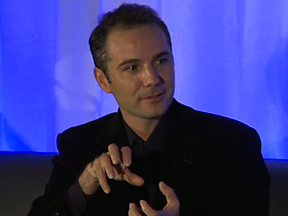
CTNX 2011: Inside the Imagination of Carlos Grangel, Part 1

Carlos Grangel at CTNX 2011 reveals insights into his character design process for films such as Corpse Bride, Shark Tale, Kung-Fu Panda, How To Train Your Dragon and more.
I’m a character designer and concept artist before I’m an animator or producer, so I was thrilled to write a post about character designer Carlos Grangel’s CTNx workshop.
I love his approach to designing characters and the collaborative effort of everyone at his studio.
A huge bonus in this session was that it was moderated by Jill Culton (see credits below) who knew just what to ask to ask Carlos to draw out statements packed with amazing insight.
(From CTNx’s Website)
Carlos Grangel, character designer and studio owner
Carlos Grangel (IMDB) is a Spanish-born character designer for animated films. Carlos started as a character designer at Amblimation-Universal Pictures in London, and worked on “We’re Back: A Dinosaur’s Story” and “Balto”.In 1995 he started designing characters for DreamWorks movies “The Prince of Egypt”, “The Road to El Dorado”, “Spirit”, “Sinbad”, “Shark Tale”, “Madagascar”, “Flushed Away”, “Bee Movie”, “Kung Fu Panda” and “How to Train Your dragon”. He owns Grangel Studios along with his brother Jordi.
Original creator with Tim Burton for the characters on “Corpse Bride”, also worked on “Pirates” and “Hotel Transylvania” for Sony/Aardman Pictures and “Why I did (not) Eat my Father” for Pathé/Boreales, he contributed designing characters for various shortfilms like “Alma”, “Passage”, “The ClockWork Clone” and “The Periwig Maker” that was nominated for the Academy Awards Best Animated Short.
Moderator Jill Culton, writer and director
Originally from Ventura, California, Jill Culton (IMDB) is a graduate from the California Institute of the Arts where she was one of only five women in the character animation class of 1990. Now, twenty years later, Culton has a thriving career in the field of computer feature animation. Having worked as an animator, character designer, concept artist, storyboard artist, Director and Executive Producer, Culton is one of the foremost talents in her industry today. She has worked for ILM, Pixar, and Dreamworks where she is currently.
Rather than list the questions Jill asked Carlos, I categorized key elements of his answers into 4 key categories: Process, Artistic Development, Studio/Business, and Features. There was so much here that I had to split it up into 2 posts. The first covers the first 3 categories and the second post will be dedicated to the key feature films Carlos has designed characters for.
PROCESS
Here are some facts and quotes regarding Grangel’s design process.
Stage 1: Shape Language and Silhouettes
In this first stage Grangel said that he looks at shapes, proportions, and costumes and how they interact.
In the sample he showed it seemed to be 40-50 designs. Grangel pointed out that he works from the outside in, focusing first on the negative space and silhouette, before adding the key inner details.
Stage 2: Medium Stage
In this stage he showed many detailed versions of a character.
Stage 3: Final stage
Grangel usually provides a few similar versions of the final character, but he shows the client/director the whole process to explain how he arrived at the finals. Hey pointed out that many times the director ends up choosing an earlier version.
Other comments included:
- “I switch techniques a lot and I try to pick the best medium to present designs for that movie.”For example, he developed some Po (Kung-Fu Panda) studies in Chinese ink on Chinese rice paper, basing the style on Chinese art.
- “I like to start with a mid tone.” (Hence the use of cereal boxes for Corpse Bride.)
- When asked how long it takes to do one of the character shape line ups Grangel replied, “About a week.” Continuing, he said, “You have to let it (the batch of loose/rough sketch designs) cook in your brain a couple of nights, then your brain will digest everything. Then it will come natural. I don’t see the first day. I’m to close to the paper, but the day after some of the more interesting designs are going to pop out.”
- Regarding his thought process, Grangel explained, “I try to put passion in everything I do.” He also mentioned that, “You create the very best where you are most happy. You have to find your space.” (this also tracked with some of Vignali’s statements (https://timbuktoons.com/2011/11/marcelovignali/) about getting into the zone.)
ARTISTIC DEVELOPMENT
When asked how someone should become a character designer, Grangel replied, “I don’t know what to tell you. I didn’t start out wanting to be a character designer.” He also pointed out that he developed into a character designer as those opportunities arose. Now it is his specialty.
Other insightful comments about artistic development included:
- “I wanted to work with anyone at the studio who would make me better. If you are a sponge you will get better.”
- “Don’t copy things. The best way is to find your own way.” (This tracked with Vignali’s statements [15 Things I Learned From Marcelo Vignali] about not following convention.)
- “I study from real life and observe a lot and I look at a lot of art books.”
Grangel pointed out that he is influenced by nature/reality as well as art in general.
- “I didn’t go for comics or illustration. I went for everything: photography, paint, sculpt, architecture…”
- “I went to museum or art exhibit every week. It was mandatory. (personal note: I did this at the Corcoran school of Art and Design in Washington, DC. I had one class where we went to a studio or museum every week, and one class where we worked in a different medium every week. I appreciate those classes much more now, I didn’t appreciate what a great opportunity that was.)
- Grangel continued saying, “I wasn’t into animation that much.”
Grangel also pointed out the collaborative nature of animation and how it helps artists develop. Hey said, “There is individual achievement in illustration, sculpting or painting, but animation is collaborative by nature.”
STUDIO/BUSINESS
Carlos owns a studio with his brother Jordi called Grangel Studios in Spain. They have been in business for 22 years with great success in the US as well as in Europe (particularly in Spain). His brother runs the commercial side including, merchandising, mascots, commercial side. He is also a great sculptor and supervised modeling on Corpse bride.
His brother and the rest of the team help with: research, sketching, preliminary studies, logo design, presentation, adding texture, and producing commercials.
Grangel said, “I do the final transformed style to be presented. The better you can present the better you can sell your designs.”
Because of their holistic treatment of character development and branding, Grangel Studios has also had the opportunity to design several posters for Dreamworks movies.
When asked about the advantages and disadvantages of owning a studio, Grangel replied, “I would suggest not to grow too much. I never fire anyone. I don’t like that. Just keep it small and try to achieve the best quality you can. The clients will keep coming.”
So much about Grangel’s work process and business philosophy synced with my thoughts and how we do things at Timbuktoons. One of my favorite quotes is from Disney/Pixar’s John Lasseter who said, “Quality is the best business plan. period.”
As far as disadvantages or difficulties, Grangel said, “If you have a gap and you have to pay your staff, that is the worst situation you may have.” Many of the studio heads in the CAO workshop (Chief Artist Officers Workshop: Part 1) commented on this as well.
During a discussion on preliminary studio meetings, Grangel stated comically, “I will say that after 3-4 weeks of all these meetings that I could scream and kill someone. So it’s better for me to stay 2-3 weeks over here then go back to Spain to work quietly in my cave. I like to produce. I like to be on the table.”
About longevity and enjoying his career Grangel said, “I don’t work weekends anymore.”
For more information go to: http://www.ctnanimationexpo.com/carlos-grangel-3/
Read Part 2 as we unpack interesting facts and highlight key feature films which Grangel has designed characters for.
